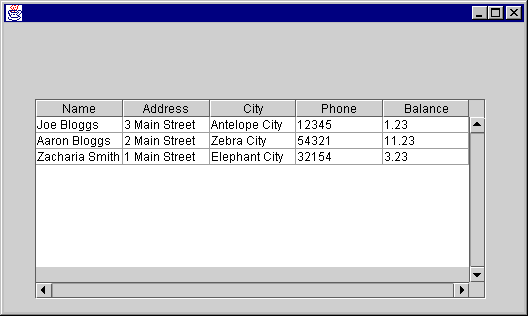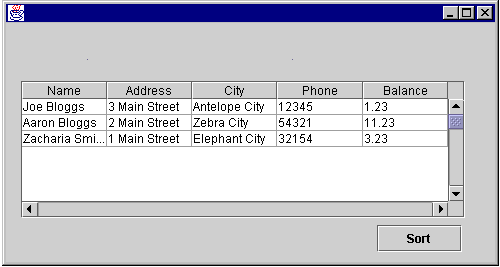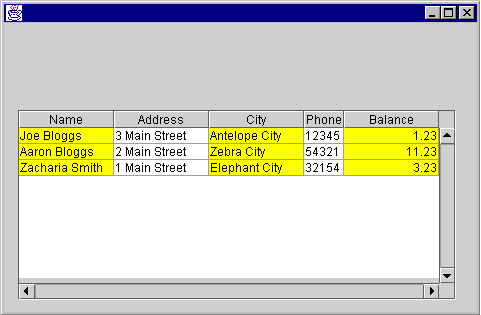 |
SORTable - Manual | ||||
| Home | Sort Table | Manual | Demo | Other Products | |
Overview
The SORTable classes provide a simple way to add sorted tables to your Java applications.
Two packages are provided
- the core SORTable Java code as provided by Virtual Machinery - com.virtualmachinery.sortedtable
- a package containing the SORTable demo code - com.virtualmachinery.sortedtable.demo
Quick Start using the JDK
How the SORTable classes work - building a sorted table with 'double-click' sorting
- Create a new class called VMTableDemo1 which extends JPanel and has an attribute sortTable which is an instance of com.virtualmachinery.sortedtable.ListPanelWithSortButton. The code for this will look something like this -
public class VMTableDemo1 extends javax.swing.JPanel {
public com.virtualmachinery.sortedtable.SortedListPanel sortTable = new com.virtualmachinery.sortedtable.ListPanelWithSortButton();
}
Next add an initialize() method which will set the Panel into the main frame of the application -
private void initialize() {
try {
setName("VMTableDemo1");
setLayout(null);
setSize(489, 239);
add(sortTable, sortTable.getName());
} catch (java.lang.Throwable ivjExc) {
System.out.println(ivjExc);
}
}
public VMTableDemo1(){
super();
initialize();
}
public static void main(java.lang.String[] args) {
try {
javax.swing.JFrame frame = new javax.swing.JFrame();
VMTableDemo1 aVMTableDemo = new VMTableDemo1();
// ******** Code to initialise table model is here ***
com.virtualmachinery.sortedtable.demo.SimpleAccountTableModel aSimpleAccountTableModel = new com.virtualmachinery.sortedtable.demo.SimpleAccountTableModel();
String[][] data = com.virtualmachinery.sortedtable.demo.TableDemoFactory.getSampleData();
aSimpleAccountTableModel.addAllRecords(data);
aVMTableDemo1.sortTable.setSortTableModel(aSimpleAccountTableModel );
// ******** End of code to initialise table model ***
frame.setContentPane(aVMTableDemo1);
frame.setSize(aVMTableDemo1.getSize());
frame.addWindowListener(new java.awt.event.WindowAdapter() {
public void windowClosing(java.awt.event.WindowEvent e) {
System.exit(0);
};
});
frame.show();
java.awt.Insets insets = frame.getInsets();
frame.setSize(frame.getWidth() + insets.left + insets.right, frame.getHeight() + insets.top + insets.bottom);
frame.setVisible(true);
} catch (Throwable exception) {
System.err.println("Exception occurred in main() of VMTableDemo1");
exception.printStackTrace(System.out);
}
}

How the SORTable classes work - building a sorted table with associated sort button
public class VMTableDemo extends javax.swing.JPanel {
public com.virtualmachinery.sortedtable.ListPanelWithSortButton sortTable = new com.virtualmachinery.sortedtable.ListPanelWithSortButton();
}

To demonstrate how easy it is to modify the appearance of the underlying JTable you can add the code below to the main method of either of the classes that you created above. In this case we are striping the columns painting each alternate one yellow. We are also altering the size of the third column and applying right alignment to the fifth column - -
/**** Start of code to change the table to show alternate colours on each column ****/
javax.swing.JTable theTable = aVMTableDemo.sortTable.getScrollPaneTable();
javax.swing.table.DefaultTableCellRenderer aRenderer = new javax.swing.table.DefaultTableCellRenderer();
aRenderer.setBackground(java.awt.Color.yellow);
theTable.getColumnModel().getColumn(3).setPreferredWidth(20);
int i = 0;
while ( i < theTable.getColumnModel().getColumnCount()) {
if (i==4) {
javax.swing.table.DefaultTableCellRenderer rend2 = new javax.swing.table.DefaultTableCellRenderer();
rend2.setBackground(java.awt.Color.yellow);
rend2.setHorizontalAlignment(javax.swing.SwingConstants.RIGHT);
theTable.getColumnModel().getColumn(i).setCellRenderer(rend2);
}
else {theTable.getColumnModel().getColumn(i).setCellRenderer(aRenderer);}
i+=2;
}
/**** End of code to change the table to show alternate colours on each column ****/
frame.show();

Creating a new class that implements the SortedTableModelInterface
The easiest way to create a new class to use which implements the interface is to extend the SortedTableModel and state that the class implements SortedTableModelInterface. This is what we have done with the SimpleAccountTableModel provided with the demo classes. Here's a step by step guide to creating the new class -
- Create your new class extending the SortedTableModel and implementing SortedTableModelInterface
- Create a method getColumnNames() which returns a string array containing the text that you wish to appear in your column headers in the order in which you wish to see it displayed
- Provide methods to add records to the backing data - the methods addAllRecords(String[][]) and addRecord(String[], int) provided are simple examples of how to do this
- Create the method sortOnField(int field, boolean ascending) which allows you to choose which method you will use to sort particular columns. You may of course choose not to allow sorting on a particular field - in this case you can do nothing but it would make sense to give some feedback to the user that sorting is not allowed on this field. You can send your feedback (e.g. a popup window) from this method as it will always be called when the user attempts to perform a sort operation